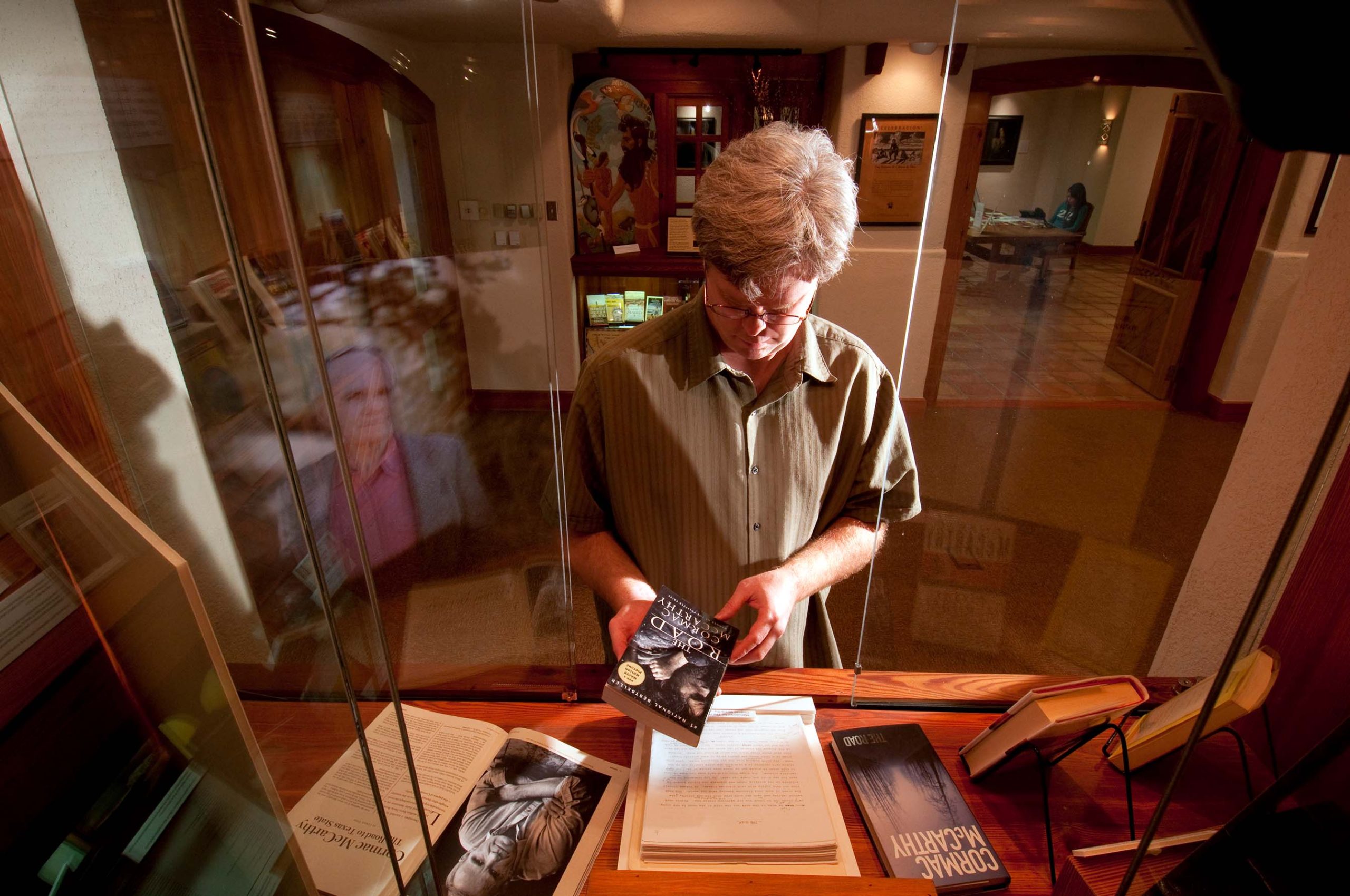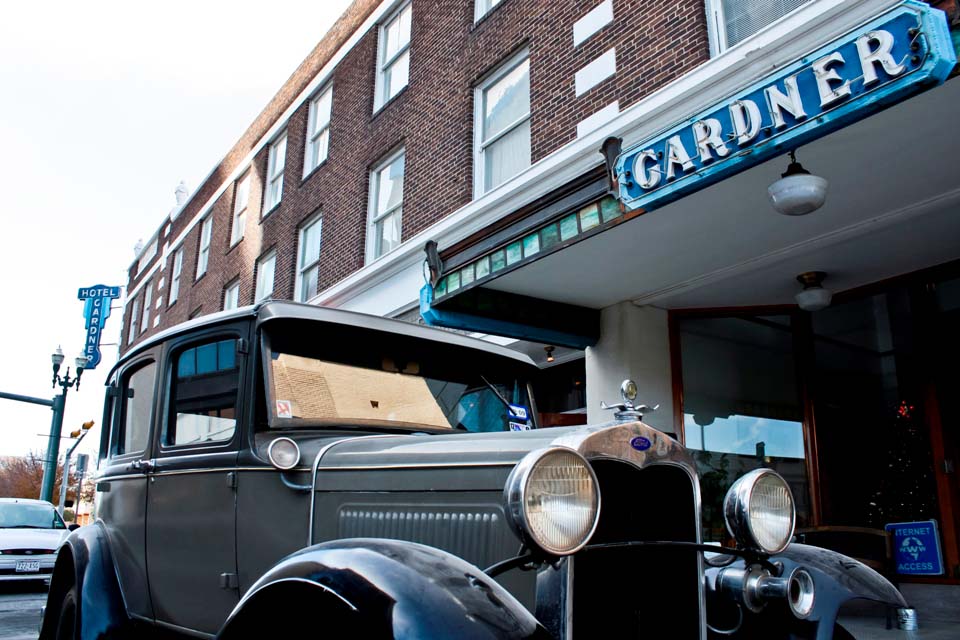
The Wittliff Collections Southwestern Writers Collection curator Steve Davis photographed in 2009 setting up for an exhibition of books and biographies of author Cormac McCarthy. Photo by Kevin Stillman
With the sad news of the passing of a literary giant Tuesday, the question was begged, “Has there ever been a writer more closely associated with Texas than Cormac McCarthy? (OK, besides Larry McMurtry.)” And while McCarthy was not native to the state (born in Rhode Island in 1933), there is no doubt he found a new voice when he decided to move to El Paso in the mid-1970s.
Before then, McCarthy made a name for himself in literary circles writing Southern Gothic novels set around Tennessee and Appalachia. He then moved to Texas where he stayed for over 20 years, writing his most memorable novels—from Blood Meridian to The Road. And while he spent most of the latter years in New Mexico chatting with the geniuses of the Santa Fe Institute, his best loved material will always have come from Texas. Even his archives are housed at The Wittliff Collections in San Marcos.
Like the characters and violent tales he so brilliantly created, the author will forever remain a part of us, so buckle up and get ready to take a road trip of Cormac McCarthy’s long road through Texas.
Blood Meridian
Nacogdoches
Historic Town Center, 200 E. Main St.
Published in 1985, Blood Meridian: or the Evening Redness in the West finds its young protagonist running away from home and ending up in this East Texas settlement, where he first encounters the novel’s ghastly antagonist, Judge Holden. This is the McCarthy novel literary critic Harold Bloom christened “the ultimate Western.” Since Nacogdoches is considered the oldest town in Texas, its Historic Town Center is a fitting place to learn more about mid-1800s Texas, when the novel is set and when Texas went from being a republic to being the 28th state of the Union.
Fort Griffin
Fort Griffin Historical Site, 1701 US 283 North (15 miles north of Albany)
Blood Meridian bookends back in Texas—only this time at Fort Griffin, which was first established in 1867 by companies of the 6th Calvary. The post existed until the U.S. Army shuttered it in 1881. During its time, the town of Fort Griffin was considered a wild place for outlaws and soldiers alike. And it’s here where the kid, now a grown man, meets the Judge for the final time. What occurs between them is best left up to the reader.
All the Pretty Horses
Various locations in San Angelo, Langtry, San Antonio, Big Bend
The first book of the Border Trilogy, All the Pretty Horses focuses on 16-year-old John Grady Cole as he and his cousin Rawlins traverse the area between San Angelo and Northern Mexico. John Grady is everything a Texas cowboy could hope to be: courageous, honorable, and a natural with both horses and Hispanic women. The novel begins in San Angelo, then heads to Langtry, aka Judge Roy Bean country (a Cormacian character in his own right). Now mostly a ghost town, you can make a pitstop at the Judge Roy Bean Visitor Center (526 State Loop 25).
In San Angelo, fans can also make a quick stop at the Concho River which passes through the Grady Ranch (maybe look for pearls as well). Or, head to San Antonio and visit the historic Menger Hotel, where John Grady’s mother performs. Many scenes in the 2000 movie adaptation directed by Billy Bob Thornton and starring Matt Damon were filmed at Big Bend National Park, where visitors can experience the hot West Texas desert for themselves.
Cities of the Plain/The Road
El Paso
Gardner Hotel, 311 E. Franklin Ave.

Courtesy of the Gardner Hotel
While the second and third novels of the Border Trilogy mostly take place in Old and New Mexico, the epilogue finds Billy Parham elderly and broken, out of his time, taking shelter in the famed Gardner Hotel. Built in 1922, this is where Cormac McCarthy took up residence and did most of his writing in the 1970s and ’80s.
While not explicitly set in Texas, McCarthy’s Pulitzer Prize-winning novel The Road absolutely was inspired by the state. As McCarthy explained in a rare interview with Oprah Winfrey, he went to El Paso and “checked into the old hotel” with his son. After his son was fast asleep, McCarthy looked out the window and “could hear the trains, in that very lonesome sound. And I just had this image of what this town might look like in 50 or 100 years.” Bleak doesn’t begin to cover what he imagined.
No Country for Old Men
Various locations in West Texas
While the town the novel begins in is unclear (in the Oscar-winning Coen brothers film, its cited as Sanderson), the landscape of the novel, and mostly the film, is uniquely West Texan. The cat and mouse game between psycho for the ages Anton Chigurh and good ol’ boy Llewelyn Moss, like the trilogy before it, finds the pair traveling all over West Texas before crossing into Mexico.
Fans can visit many of the locations near Marfa like where Chigurh pulls over an unsuspecting victim, the gate that leads to the deal gone wrong or the horizon shown in Tommy Lee Jones’ opening monologue. Most of the in-town locations were filmed in Las Vegas, New Mexico, but characters like Sheriff Ed Tom Bell and Moss, even Carla Jean Moss and Loretta Bell, are as Texan as Willie Nelson’s Fourth of July Picnic.








